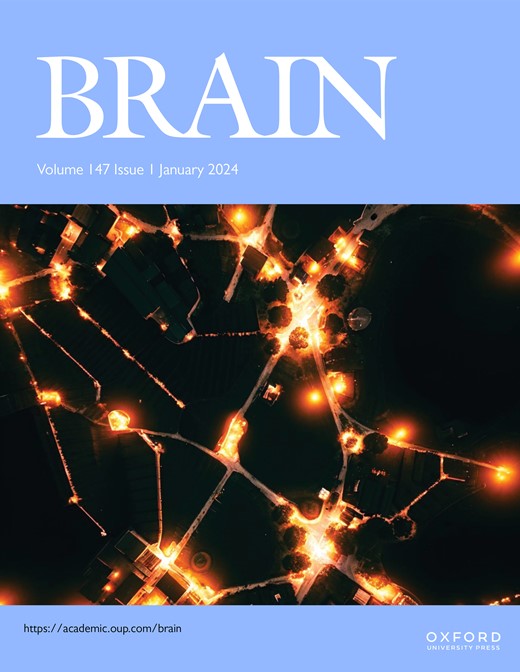数据驱动的原发性进行性失语症神经解剖亚型
IF 10.6
1区 医学
Q1 CLINICAL NEUROLOGY
引用次数: 0
摘要
原发性进行性失语症是一种罕见的以语言为主导的痴呆症,主要有三种变体:语义型、非语言/语法型和对数开放型。语义型变体有明确的神经解剖特征,而非流利/语法型和对数开放型变体则很难从神经影像学上区分。以前的表型驱动研究已经描述了每种变体在核磁共振成像上的神经解剖特征。在这项工作中,我们使用了一种名为 SuStaIn 的机器学习算法来发现数据驱动的神经解剖学 "亚型 "进展特征,并进行了深入的亚型表型分析,以描述原发性进行性失语症的异质性。我们的研究包括 270 名在 UCL 皇后广场神经学研究所痴呆症研究中心接受研究的原发性进行性失语症患者,其中 137 名患者接受了后续扫描。该数据集包括被诊断出患有所有三种主要变异的患者(语义型:94人;非语义/语法型:109人;对数开放型:51人)以及未指定原发性进行性失语症患者(16人)。为了验证我们的研究结果,我们使用了来自 ALLFTD 北美队列研究的 66 名患者(语义型:37 人,非流利型/语法型:29 人)的数据集。我们对核磁共振成像扫描进行了分割,并在 19 个感兴趣区使用了 SuStaIn 来识别独立于诊断的神经解剖特征。我们评估了亚型和分期的分配及其纵向一致性。我们发现了原发性进行性失语症的四种神经解剖亚型,分别称为 S1(左颞)、S2(岛叶)、S3(颞顶)和 S4(额顶),这些亚型在统计检查中表现出稳健性。S1 与语义变异密切相关,而 S2、S3 和 S4 则与对数开放性和非流利/语法变异表现出混合关联。值得注意的是,S3 显示的神经解剖学特征类似于只有对数开放变异的特征,但相当一部分对数开放变异病例被分配到 S2 中。非流利语/语法变异与 S2、S3 和 S4 有多种关联。神经解剖亚型与不明病例之间没有明确的关系。在首次随访中,84% 患者的亚型分配是稳定的,91.9% 患者的分期分配是稳定的。我们在 ALLFTD 数据集中部分验证了我们的研究结果,发现了类似的定性模式。我们的研究利用大型原发性进行性失语症数据集上的机器学习,划分出了四种不同的神经解剖模式。我们的研究结果表明,在原发性进行性失语症谱系中确实存在可分离的时空神经解剖表型,但这些表型是嘈杂的,尤其是对 nfvPPA 和 lvPPA 而言。此外,这些表型并不总是符合临床解剖学相关性的标准公式。了解这种疾病的多方面特征,包括神经解剖、分子、临床和认知方面,对临床决策支持具有潜在的意义。本文章由计算机程序翻译,如有差异,请以英文原文为准。
Data-driven neuroanatomical subtypes of primary progressive aphasia
The primary progressive aphasias are rare, language-led dementias, with three main variants: semantic, non-fluent/agrammatic, and logopenic. Whilst semantic variant has a clear neuroanatomical profile, the non-fluent/agrammatic and logopenic variants are difficult to discriminate from neuroimaging. Previous phenotype-driven studies have characterised neuroanatomical profiles of each variant on MRI. In this work we used a machine learning algorithm known as SuStaIn to discover data-driven neuroanatomical “subtype” progression profiles and performed an in-depth subtype–phenotype analysis to characterise the heterogeneity of primary progressive aphasia. Our study included 270 participants with primary progressive aphasia seen for research in the UCL Queen Square Institute of Neurology Dementia Research Centre, with follow-up scans available for 137 participants. This dataset included individuals diagnosed with all three main variants (semantic: n=94, non-fluent/agrammatic: n=109, logopenic: n=51) as well as individuals with un-specified primary progressive aphasia (n=16). A data set of 66 patients (semantic n=37, non-fluent/agrammatic: n=29) from the ALLFTD North American cohort study, was used to validate our results. MRI scans were segmented and SuStaIn was employed on 19 regions of interest to identify neuroanatomical profiles independent of the diagnosis. We assessed the assignment of subtypes and stages, as well as their longitudinal consistency. We discovered four neuroanatomical subtypes of primary progressive aphasia, labelled S1 (left temporal), S2 (insula), S3 (temporoparietal), S4 (frontoparietal), exhibiting robustness to statistical scrutiny. S1 correlated strongly with semantic variant, while S2, S3, and S4 showed mixed associations with the logopenic and non-fluent/agrammatic variants. Notably, S3 displayed a neuroanatomical signature akin to a logopenic only signature, yet a significant proportion of logopenic cases were allocated to S2. The non-fluent/agrammatic variant demonstrated diverse associations with S2, S3, and S4. No clear relationship emerged between any of the neuroanatomical subtypes and the unspecified cases. At first follow up 84% of patients’ subtype assignment was stable, and 91.9% of patients’ stage assignment was stable. We partially validated our findings in the ALLFTD dataset, finding comparable qualitative patterns. Our study, leveraging machine learning on a large primary progressive aphasia dataset, delineated four distinct neuroanatomical patterns. Our findings suggest that separable spatio-temporal neuroanatomical phenotypes do exist within the PPA spectrum, but that these are noisy, particularly for nfvPPA and lvPPA. Furthermore, these phenotypes do not always conform to standard formulations of clinico-anatomical correlation. Understanding the multifaceted profiles of the disease, encompassing neuroanatomical, molecular, clinical, and cognitive dimensions, holds potential implications for clinical decision support.
求助全文
通过发布文献求助,成功后即可免费获取论文全文。
去求助
来源期刊

Brain
医学-临床神经学
CiteScore
20.30
自引率
4.10%
发文量
458
审稿时长
3-6 weeks
期刊介绍:
Brain, a journal focused on clinical neurology and translational neuroscience, has been publishing landmark papers since 1878. The journal aims to expand its scope by including studies that shed light on disease mechanisms and conducting innovative clinical trials for brain disorders. With a wide range of topics covered, the Editorial Board represents the international readership and diverse coverage of the journal. Accepted articles are promptly posted online, typically within a few weeks of acceptance. As of 2022, Brain holds an impressive impact factor of 14.5, according to the Journal Citation Reports.
 求助内容:
求助内容: 应助结果提醒方式:
应助结果提醒方式:


